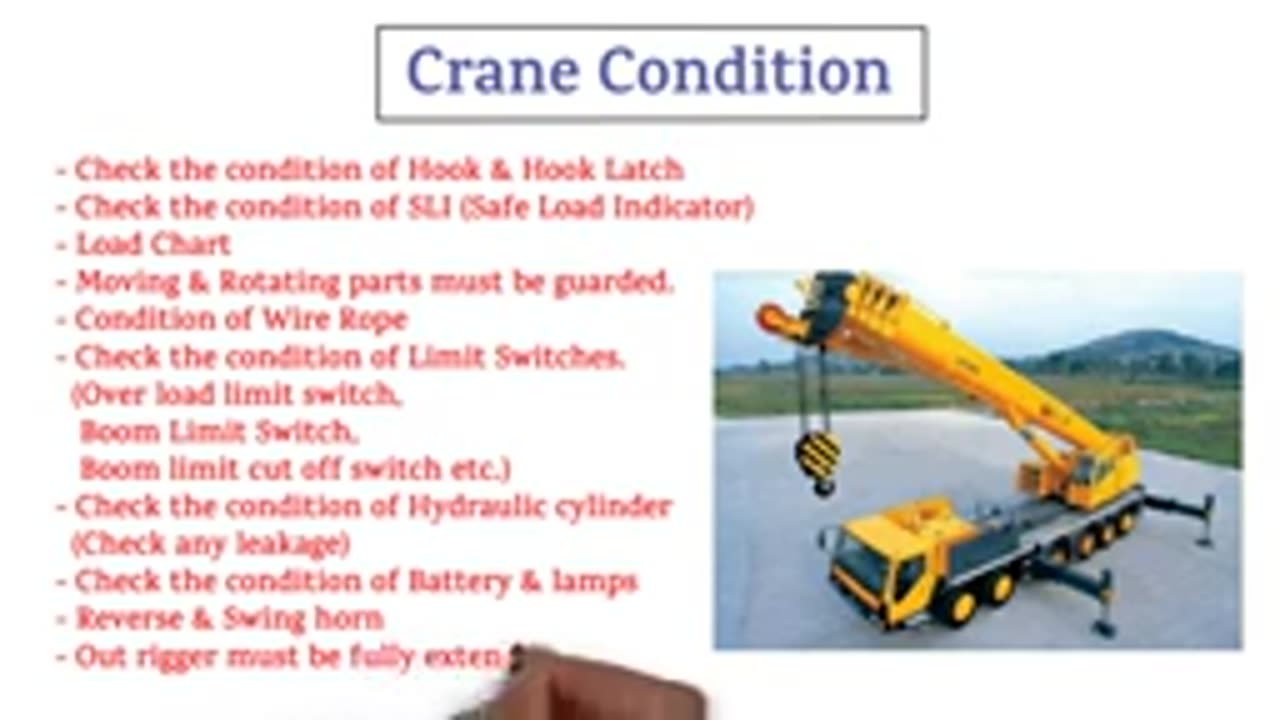Premium Only Content

Crane Inspection - How To Inspect Crane - Crane Inspection Important Points_2
### **Crane Inspection: Important Points and Guidelines**
This guide covers the key steps and critical points to consider during a crane inspection, ensuring safe and efficient crane operations.
---
## **1. Types of Crane Inspections**
1. **Pre-Operational Inspections (Daily/Before Use):**
- Conducted at the start of each shift to identify immediate safety hazards.
2. **Periodic Inspections:**
- Performed monthly or quarterly based on usage and regulatory requirements.
3. **Annual Inspections:**
- Comprehensive checks carried out by certified inspectors.
---
## **2. Key Crane Inspection Points**
### **2.1. Structural Components**
- **Boom and Jib:**
- Check for cracks, bends, corrosion, or dents.
- Ensure proper alignment and smooth operation.
- **Frame and Chassis:**
- Inspect for structural damage, rust, or missing bolts.
- Confirm that outriggers extend and lock securely.
---
### **2.2. Load Handling Equipment**
- **Hooks:**
- Inspect for cracks, deformation, or wear.
- Ensure the safety latch is functional.
- **Wire Ropes:**
- Look for kinks, fraying, broken wires, or corrosion.
- Check for proper spooling on the drum without overlapping.
- **Sheaves:**
- Ensure they are free of cracks and turn smoothly.
- Inspect grooves for wear and proper alignment.
---
### **2.3. Hydraulic Systems**
- **Hoses and Connections:**
- Check for leaks, cracks, or bulges.
- Ensure secure connections at fittings.
- **Cylinders:**
- Inspect for dents or leaks around seals.
- Test for smooth operation during boom movement.
- **Fluid Levels:**
- Verify hydraulic oil levels are within acceptable limits.
---
### **2.4. Mechanical Systems**
- **Hoist Mechanism:**
- Ensure the hoist drum operates smoothly without jerking.
- Inspect brake systems for wear and proper functioning.
- **Slewing Ring (Rotating Mechanism):**
- Check for cracks, missing bolts, and smooth rotation.
- **Gearboxes and Bearings:**
- Look for signs of overheating, noise, or wear.
- Confirm lubrication levels are adequate.
---
### **2.5. Electrical Systems**
- **Control Panel:**
- Test all switches, buttons, and joysticks for functionality.
- **Warning Alarms and Indicators:**
- Verify operational status of alarms, lights, and load moment indicators (LMI).
- **Wiring:**
- Check for exposed or frayed wires, loose connections, or overheating.
---
### **2.6. Safety Systems**
- **Anti-Two-Block Device:**
- Test to ensure it prevents the hook block from contacting the boom tip.
- **Emergency Stop:**
- Confirm the emergency stop button halts all operations immediately.
- **Load Limiters:**
- Ensure the crane stops lifting when the load exceeds its rated capacity.
---
### **2.7. Mobility and Stability**
- **Tires or Tracks:**
- Inspect for wear, proper inflation, and alignment.
- For tracked cranes, check for loose or damaged tracks.
- **Outriggers and Pads:**
- Ensure full extension and proper locking.
- Verify pads or mats are used on soft or uneven surfaces.
- **Counterweights:**
- Check for secure attachment and proper weight according to the load chart.
---
## **3. General Inspection Guidelines**
1. **Documentation:**
- Verify the availability of load charts, operator manuals, and previous inspection records.
2. **Environment:**
- Ensure the crane operates on stable, level ground.
- Check for overhead obstacles (e.g., power lines, structures).
3. **Tagging:**
- Tag the crane as "Out of Service" if defects are identified.
- Do not operate until all issues are repaired and re-inspected.
---
## **4. Inspection Tools and Equipment**
- Flashlight for detailed visual inspections.
- Measuring tools (e.g., calipers) for wear assessment.
- Torque wrench for verifying bolt tightness.
- Lubrication equipment for maintaining moving parts.
---
## **5. Recordkeeping**
- Maintain detailed logs for:
- Inspection dates.
- Inspector’s name and qualifications.
- Observations and corrective actions taken.
- Repairs or replacements performed.
---
## **6. Common Issues to Watch For**
1. **Structural Damage:**
- Cracks, bends, or corrosion in load-bearing parts.
2. **Hydraulic Leaks:**
- Fluid seeping from hoses or cylinders.
3. **Wire Rope Wear:**
- Broken strands, kinks, or flattened sections.
4. **Operational Malfunctions:**
- Jerky movements, excessive noise, or slow response times.
---
## **7. Frequency of Inspections**
- **Frequent Use:**
- Daily or before each shift for cranes in constant operation.
- **Moderate Use:**
- Weekly or biweekly for cranes used occasionally.
- **Regulatory Compliance:**
- Follow local, national, and manufacturer guidelines for inspection intervals.
---
## **8. Safety Precautions During Inspection**
- Use personal protective equipment (PPE) such as gloves, helmets, and safety boots.
- Block or immobilize moving parts before inspection.
- Avoid working under suspended loads.
---
### **End of Guide**
Would you like help preparing a detailed checklist or visual aids for crane inspections?
-
 39:37
39:37
BonginoReport
4 hours agoCrybaby Crenshaw’s Latest Meltdown (Ep.147) - 02/25/2025
86.1K180 -
 LIVE
LIVE
Wendy Bell Radio
5 hours agoThe Party's Over
12,781 watching -

Randi Hipper
56 minutes agoBitcoin CRASHES to 3 month low! Crypto investors BEWARE
6.48K1 -
 LIVE
LIVE
Conspiracy Pilled
11 hours agoAvowed
77 watching -
 5:31
5:31
Adam Does Movies
23 hours ago $3.00 earnedThe Monkey Movie Review - This Is From The Longlegs Director?
19.2K3 -
 14:47
14:47
Tactical Considerations
15 hours ago $3.99 earnedClassic Precision Woox Furiosa Bergara Premier 6.5 CREED
21.3K1 -
 40:44
40:44
Rethinking the Dollar
1 day agoDonald & Elon Head to Fort Knox—What Are They Planning?
25.6K22 -
 1:10:15
1:10:15
MTNTOUGH Fitness Lab
1 day ago"My Baseball Career Wasn't Enough": Adam LaRoche's Life-Changing Anti-Trafficking M
20.8K4 -
 1:00:12
1:00:12
The Tom Renz Show
20 hours agoComing to America & Coming to Christ
41.1K7 -
 1:12:21
1:12:21
TheRyanMcMillanShow
1 day ago $0.43 earnedDebbie Lee: Mother of First Navy Seal Killed In Iraq, Marc Lee - RMS 019
17.2K1